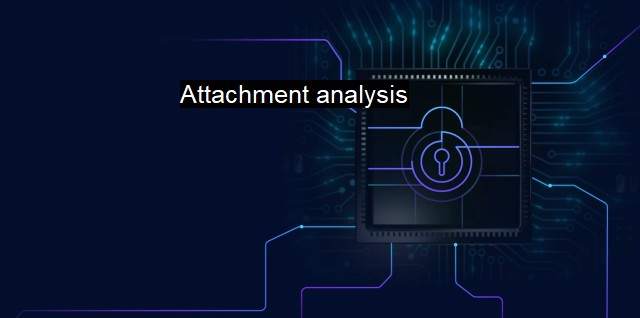What are Attachment analysis?
The Vital Role of Attachment Analysis in Cybersecurity: Identifying and Combating Malicious Threats
Attachment analysis is a critical component in the realm of cybersecurity and antivirus strategies. It is a systematic approach used in investigating files that are transmitted from one network location to another. In an era where cyber threats are ubiquitous and increasingly destructive, the relevance and necessity of attachment analysis have become imperative for individual users, corporations, and governments alike.In a typical digital transaction, users often interact with various forms of attachments such as documents, images, video files, audio files, Pdfs, or even software extensions. Although these files have made data transaction simpler, they have also become a conduit for infiltrating harmful programs and software such as viruses, ransomware, malware, and other computer-assisted threats.
The essence of attachment analysis lies in meticulously studying the materials transmitted via these attachments to determine their safety or risk levels. Each attachment’s origin, file-type, size, and content can provide valuable information that characterizes its potential of harboring threats. Therefore, comprehensive attachment analysis is a crucial step in preventing unauthorized access, information theft, software corruption and consequently, various forms of cybersecurity breaches.
Often, essential elements of cybersecurity such as antivirus programs and firewalls can perform fundamental attachment analysis. These engines keep an updated listing of known harmful file types and sources, and they scan all transferred files to match any painstaking similarities to known threats. When attachment analysis tools detect threats or irregularities, the risky attachment is usually quarantined or precluded from entering the system until further investigation and problem resolution.
Despite the effective function of traditional antivirus programs, cyber-attackers continuously invent sophisticated tactics and harmful programs that can bypass basic screening processes. Therefore, cybersecurity leaders invest heavily in advanced, proactive attachment analysis technologies such as specialized programs that analyze, manage, detect, and respond to threats. These technologies often incorporate Artificial Intelligence and Machine Learning to help identify suspicious patterns and propose the most appropriate response.
Machine Learning model implementation allows the antivirus to not only confront known issues but also adapt to emerging threats. It adapts new detection methods in real-time and augments the overall capacity of antivirus software to manage the advancing nature of cyber threats.
A specific example of advanced attachment analysis is what we see in email security services. Attachments that arrive through emails are scanned, sandboxed, or even detonated in a controlled environment to investigate their behavior and assess if they are harmless or harmful.
Professionals frequently use static and dynamic analysis for attachments within cybersecurity. Static analysis studies the underlying codes in a file attachment without activating its functions. A subsequent dynamic analysis allows the attachment to operate within a risk-free environment to observe how it behaves when in full function. This practice provides valuable insights into the malicious activities that an attachment might cause if opened in an unprotected setting.
Attachment analysis is not solely the function of technology and software; it also requires coherent human awareness and understanding. Users must be aware of the important precautions such as refraining from opening suspicious attachments or clicking on unverified links.
Attachment analysis is a crucial mechanism in combating today's increasing cybersecurity threats. Incorporating both fundamental antivirus strategies, sophisticated technological trends like AI and ML, static and dynamic analysis and a mindful approach by the users themselves, attachment analysis will continue playing a driving role in further developing our defense systems against the multi-faceted, innovating world of cyber threats.

Attachment analysis FAQs
What is attachment analysis in cybersecurity and antivirus?
Attachment analysis is a process of examining email attachments or files to detect and remove any malware that might be embedded within them. It is an essential component of antivirus software and helps protect users from potential cyber threats.How does attachment analysis work?
Attachment analysis works by scanning the content of an email attachment or file to identify any potentially malicious code. The analysis can be done through different techniques such as sandboxing, behavioral analysis or signature-based detection. If the analysis detects any malicious activity, the attachment is blocked or isolated to prevent it from harming the system.Why is attachment analysis important for cybersecurity?
Attachment analysis is significant in cybersecurity because malicious attachments can be used as a common entry point for attackers. By analyzing and detecting these attachments, antivirus software can prevent malware from reaching a user's device, network or system. Regular attachment analysis is essential to keep up with the ever-evolving cyber threats and ensure maximum security for users.What are the benefits of using attachment analysis in antivirus software?
The primary benefit of using attachment analysis in antivirus software is to protect users' devices and networks from malware threats. It provides an additional layer of security by detecting and blocking potentially harmful attachments before they can cause damage. Attachment analysis also helps in reducing false positives by accurately identifying the malicious attachments, which saves time and resources for cybersecurity professionals.| | A | | | B | | | C | | | D | | | E | | | F | | | G | | | H | | | I | | | J | | | K | | | L | | | M | |
| | N | | | O | | | P | | | Q | | | R | | | S | | | T | | | U | | | V | | | W | | | X | | | Y | | | Z | |
| | 1 | | | 2 | | | 3 | | | 4 | | | 7 | | | 8 | | |||||||